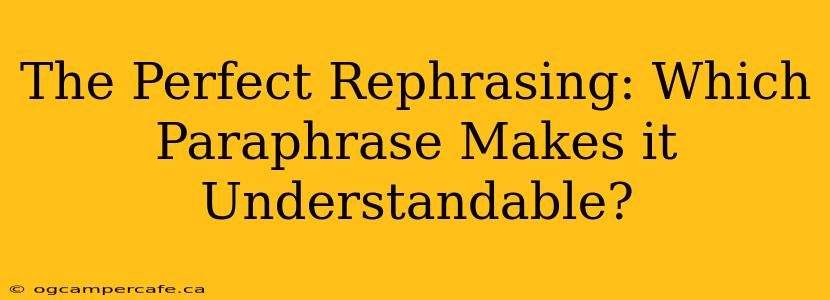Rephrasing is a crucial skill for clear communication, whether you're writing an essay, giving a presentation, or simply having a conversation. A well-crafted paraphrase conveys the original meaning accurately but in a more accessible or suitable way. However, not all paraphrases are created equal. Some retain the original meaning perfectly, while others obscure it or change its intended nuance. Let's explore how to identify a truly effective paraphrase.
What Makes a Paraphrase Understandable?
The primary goal of a paraphrase is to simplify complex information or adjust the tone to fit a specific audience. An understandable paraphrase achieves this by:
- Accuracy: The most important aspect is retaining the original meaning. No crucial information should be lost, and the overall message must remain consistent.
- Clarity: The rephrased text should be easier to understand than the original. This often involves breaking down complex sentences, using simpler vocabulary, and employing a more straightforward structure.
- Conciseness: While maintaining accuracy, unnecessary words or phrases should be eliminated. A good paraphrase is efficient and to the point.
- Context: The paraphrase should fit seamlessly into the surrounding text and context. Its style and tone should be consistent with the overall piece.
- Originality: While conveying the same meaning, the paraphrase should avoid simply replacing words with synonyms. It should demonstrate a genuine understanding of the original text and reflect it in a new way.
Identifying a Good Paraphrase: A Case Study
Let's consider an example:
Original Sentence: "The ubiquitous nature of digital technology has profoundly impacted societal structures and interpersonal interactions, necessitating a critical examination of its long-term consequences."
Here are three potential paraphrases:
Paraphrase 1: "Technology is everywhere and has changed how we live and talk to each other. We need to think about what will happen in the future."
Paraphrase 2: "Digital technology is so common now that it has deeply affected society and relationships. It's important to study its effects on the future."
Paraphrase 3: "The widespread use of digital tech has drastically altered social structures and communication patterns. A thorough analysis of its long-term implications is essential."
Which paraphrase is best?
Paraphrase 1 is too simplistic and loses the nuance of the original. Paraphrase 3 is the most effective because it maintains the accuracy and sophisticated tone of the original while employing slightly simpler language. Paraphrase 2, while accurate, lacks the precise vocabulary of the original and is slightly less clear.
How to Improve Your Paraphrasing Skills
- Understand the Original Text: Read it carefully, multiple times if necessary. Ensure you fully grasp its meaning before attempting a paraphrase.
- Break It Down: Divide the original text into smaller, more manageable chunks. Rephrase each chunk individually before combining them.
- Use Different Words: Avoid simply replacing words with synonyms. Try to express the same idea using a completely different sentence structure and vocabulary.
- Check for Accuracy: Compare your paraphrase to the original text. Make sure you haven't altered the meaning in any way.
- Seek Feedback: Ask someone else to read your paraphrase and see if they understand it and whether it accurately reflects the original meaning.
Frequently Asked Questions (FAQ)
What is the difference between summarizing and paraphrasing?
Summarizing condenses the main points of a longer text into a shorter version. Paraphrasing rewrites a specific section or sentence while maintaining the original meaning.
Is it plagiarism if I paraphrase without citing the source?
Yes, even paraphrasing requires proper citation. While you're using your own words, the ideas still belong to the original author.
How can I avoid plagiarism when paraphrasing?
Understand the original thoroughly, use your own words and sentence structures, and always cite your source.
What are some common mistakes to avoid when paraphrasing?
Oversimplifying, changing the meaning, relying too heavily on synonyms, and forgetting to cite the source.
By understanding the principles of effective paraphrasing and practicing regularly, you can improve your communication skills and avoid potential pitfalls such as plagiarism. The ability to clearly and accurately convey information is a valuable asset in any field.
